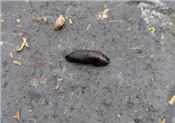Slug Management In Illinois Field Crops
NICK SEITER, TALON BECKER AND NATHAN JOHANNING
URBANA, ILL.
Slugs can be a difficult pest to manage when conditions are favorable for them, which has been the case often (particularly in southern Illinois) over the last couple of years. These mollusks can damage both corn and soybean early in the season, along with a variety of other crops; however, they have the potential to be especially problematic in soybean, where they can kill the cotyledons and ultimately reduce stands. There are a few management points to consider for slugs in field crops:
• Monitor slugs before planting to estimate the severity of the problem. Slugs can be monitored by inspecting residue, or by creating artificial shelters (made from shingles or other flat materials placed in the field to create a dark, damp environment) and inspecting them periodically before planting and during early stand establishment.1
• Cool, wet weather during stand establishment results in greater slug problems. Slugs require a moist environment to survive, and they perform best when conditions are wet. Cooler temperatures extend soil drying time and delay plant development, leaving seedlings vulnerable to slug feeding damage for a longer period of time. Discussions with several CCAs in southern Illinois highlighted the fact that, while slug damage is a fairly normal occurrence on a small scale in most years, particularly in no-till fields, the mild winter of 2017 followed by wet and cool conditions in the spring after many acres had already been planted likely contributed to the greater incidence of slug damage last season. It appears that soybeans were most affected last season in southern Illinois, with several thousand acres of replanting reported.
• Reduced tillage and/or certain cover crop systems can lead to larger slug populations. Higher levels of residue retain water and provide harborage for slugs, resulting in an increased probability of slugs reaching damaging levels. Reports from southern Illinois indicate that most problem fields last spring had a cereal rye cover crop that had not been terminated before producing excessive growth, creating a favorable environment for slugs. It is important to manage residue in cover cropped fields, particularly if they are no-till. If you had a problem with slugs last year, or have found concerning levels under your “shingle traps” in the field, make it a priority to terminate the cover crop before too much above ground biomass has accumulated (generally less than 1 ft. of growth). Cover croppers may also consider decreasing their seeding rate or planting a cover crop mix which includes species that winter-kill along with their favorite over-wintering species.
• Avoid open seed furrows. When planter closing wheels fail to seal the furrow, the resulting trench provides an ideal environment for slugs and allows them to consume developing cotyledons as the seed germinates.
• Chemical control options are limited. Slugs are not insects, and insecticides do not provide effective control. There are slug-specific baits available, but they tend to be expensive. Note that several formulations of the active ingredient metaldehyde (e.g., Deadline®) are labeled for use in corn, but this molluscicide is not currently labeled for soybean in Illinois.
Ultimately, the most reliable management tactic for slugs is to plant into a warm, dry seed bed, which is not always an option. However, by understanding conditions which are likely to lead to slug problems, you can be better prepared to address them when and where they occur. ∆
DR. NICK SEITER: Research Assistant Professor, Field Crop Entomologist, University of Illinois
TALON BECKER: Extension Educator, Agriculture and Natural Resources, University of Illinois
NATHAN JOHANNING: Extension Educator, Agriculture and Natural Resources, University of Illinois

A slug found under a shingle trap placed in a field prior
to planting in southern Illinois.
Photo courtesy Talon Becker